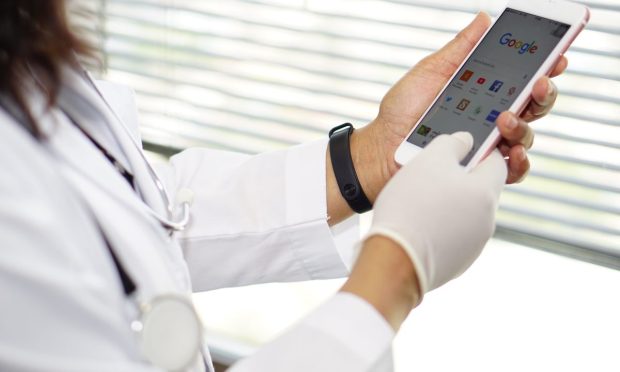Google Health Revamps With 3-Pronged Focus on Doctors, Diagnostics and Data

The connected healthcare ecosystem is coming together in fits and starts, with Big Tech players increasing efforts to grow into the sector with new cloud, artificial intelligence (AI) and data-driven solutions.
That’s turning out to be easier said than done, as evidenced by the disbanding of Google Health in August. In a recent CNBC “Squawk Box” segment, Google Chief Health Officer Karen DeSalvo spoke of the company’s revamped approach, focusing on cloud and AI for diagnostics, and EHR.
“We’re still thinking of three big buckets where we can make a difference,” DeSalvo told CNBC, saying that consumer health is first in line through connected wearables like its Fitbit device that measures vitals and movement, and enhancements of search, YouTube and Google Maps.
She said “the second bucket is caregivers, so we are still working on tools like Care Studio that give information at the bedside” sparing doctors the need to hunt for patient information. Google’s third bucket — and arguably its biggest push into connected — “is context, where people live, learn, work and play, these social determinants of health.”
Along those lines, in September Mayo Clinic selected Google as its strategic partner for cloud computing and AI to drive medical innovation. According to a statement, “Mayo Clinic selected Google Cloud to be the cornerstone of its digital transformation,” adding that “Google Cloud will secure and store Mayo Clinic’s data, while working with Mayo Clinic to apply AI and other cloud computing technologies to solve complex health care problems.”
Consumer demand for connected services is up, with PYMNTS’ study Connected Healthcare: What Consumers Want From Their Healthcare Customer Experiences, a collaboration with Rectangle Health, noting that “Patients who are willing to leave their current providers to access digital options identified tools that helped them save time, keep track of payments and interact securely with their healthcare providers as their top motivations for switching.”
Read: Connected Healthcare: What Consumers Want From Their Healthcare Customer Experiences
Healthcare Billing Checkup
Healthcare billing and payments are another area prime for innovation.
On Oct. 18, Blue Shield of California announced its partnership with Google Cloud, stating that “By developing a scalable cloud platform that will integrate solutions from Blue Shield’s other technology partners, the companies will digitize health care claims using automated processing, artificial intelligence, and machine learning technologies to greatly improve the accuracy and timeliness of billing information and claims payment.”
On that front, DeSalvo told CNBC, “We’re building an environment where consumers should be able to access their health data. Technology enables it. But we have to ensure that the business sector and the healthcare sector respects and understands that they should be sharing that data with consumers so they can have more control over their health.”
In The Payment Cure: How Improving Billing Experiences Impacts Patient Loyalty, a PYMNTS and CareCredit collaboration, found that the transparency DeSalvo described aligns with patient expectations in the pandemic era that’s brought about the digital shift in healthcare.
Per The Payment Cure study, “The majority of patients stated that cost transparency matters to their assessment of their healthcare experiences: 65 percent stated being made aware of the potential cost of treatment before an appointment creates an overall positive experience,” while just 30 percent of patients are able to access a cost estimate prior.
Read: The Payment Cure: How Improving Billing Experiences Impacts Patient Loyalty
